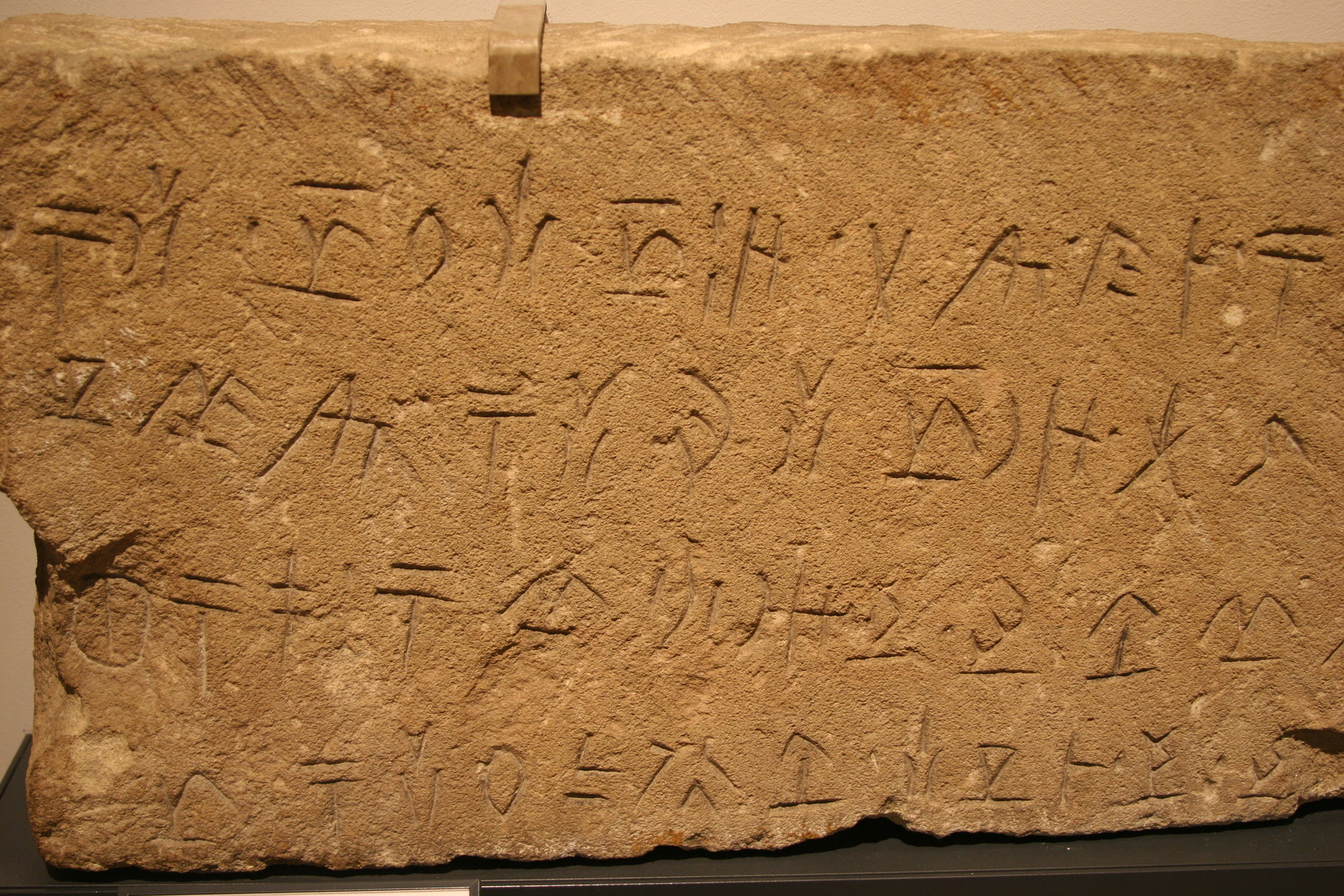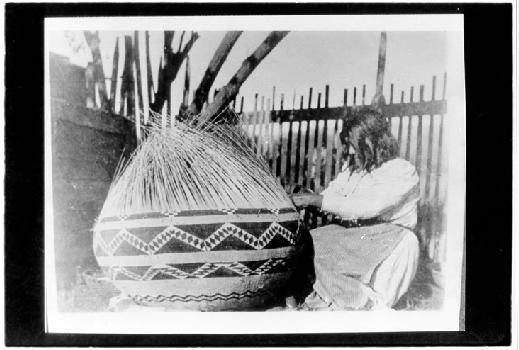|
Laura Somersal
Laura Fish Somersal (born Dolores Fish 1892 – 1990) was a Pomo - Wappo basket weaver, educator and the last speaker of the Wappo language. Biography Fish was born Dolores Fish in Geyserville, California on December 10, 1892. She was the daughter of Bill Fish, of the Southern Pomo language, Southern Pomo tribe and Mary John Eli of the Wappo, Wappo people. In 1915, she moved to the Dry Creek Rancheria, where her ancestors cultivated Cyperaceae, sedge for basketmaking in the Dry Creek Valley before the arrival of white settlers. Over the course of her lifetime, she was witness to the dwindling and near loss of her tribes, the land they called home in California's Sonoma Valley, and the traditional materials used to create the intricate baskets she became known for. Basketry Her cousin first taught her the Pomo basket weaving style at age eight. She would learn from elders in her community and grew her talent, eventually becoming one of the most talented Pomo basket weavers. ... [...More Info...] [...Related Items...] OR: [Wikipedia] [Google] [Baidu] |
Pomo
The Pomo are a Indigenous peoples of California, Native American people of California. Historical Pomo territory in Northern California was large, bordered by the West Coast of the United States, Pacific Coast to the west, extending inland to Clear Lake (California), Clear Lake, mainly between Cleone, California, Cleone and Duncans Point. One small group, the Tceefoka (Northeastern Pomo language, Northeastern Pomo), lived in the vicinity of present-day Stonyford, California, Stonyford, Colusa County, California, Colusa County, where they were separated from the majority of Pomo lands by Yuki people, Yuki and Wintuan languages, Wintuan speakers. The name ''Pomo'' derives from a conflation of the Pomo words and . It originally meant "those who live at red earth hole" and was once the name of a village in southern Potter Valley, California, Potter Valley, near the present-day community of Pomo, California, Pomo, Mendocino County, California, Mendocino County. The word may also ha ... [...More Info...] [...Related Items...] OR: [Wikipedia] [Google] [Baidu] |
Extinct Language
An extinct language or dead language is a language with no living native speakers. A dormant language is a dead language that still serves as a symbol of ethnic identity to an ethnic group; these languages are often undergoing a process of revitalisation. Languages that have first-language speakers are known as modern or living languages to contrast them with dead languages, especially in educational contexts. Languages have typically become extinct as a result of the process of cultural assimilation leading to language shift, and the gradual abandonment of a native language in favor of a foreign ''lingua franca''. As of the 2000s, a total of roughly 7,000 natively spoken languages existed worldwide. Most of these are minor languages in danger of extinction; one estimate published in 2004 expected that some 90% of the languages spoken at that time will have become extinct by 2050. Language death Normally the transition from a spoken to an extinct language occurs when a ... [...More Info...] [...Related Items...] OR: [Wikipedia] [Google] [Baidu] |
Pomo Basket Weavers
The Pomo are a Native American people of California. Historical Pomo territory in Northern California was large, bordered by the Pacific Coast to the west, extending inland to Clear Lake, mainly between Cleone and Duncans Point. One small group, the Tceefoka (Northeastern Pomo), lived in the vicinity of present-day Stonyford, Colusa County, where they were separated from the majority of Pomo lands by Yuki and Wintuan speakers. The name ''Pomo'' derives from a conflation of the Pomo words and . It originally meant "those who live at red earth hole" and was once the name of a village in southern Potter Valley, near the present-day community of Pomo, Mendocino County. The word may also have referred to the local deposits of red magnesite (mined and utilized for making red beads) or to the reddish, earthen clay soil of the area, rich in hematite (also mined for use). In the Northern Pomo dialect, ''-pomo'' or ''-poma'' was used as a suffix after the names of places, to mean a ... [...More Info...] [...Related Items...] OR: [Wikipedia] [Google] [Baidu] |
American Basket Weavers
American(s) may refer to: * American, something of, from, or related to the United States of America, commonly known as the "United States" or "America" ** Americans, citizens and nationals of the United States of America ** American ancestry, people who self-identify their ancestry as "American" ** American English, the set of varieties of the English language native to the United States ** Native Americans in the United States, indigenous peoples of the United States * American, something of, from, or related to the Americas, also known as "America" ** Indigenous peoples of the Americas * American (word), for analysis and history of the meanings in various contexts Organizations * American Airlines, U.S.-based airline headquartered in Fort Worth, Texas * American Athletic Conference, an American college athletic conference * American Recordings (record label), a record label that was previously known as Def American * American University, in Washington, D.C. Sports teams S ... [...More Info...] [...Related Items...] OR: [Wikipedia] [Google] [Baidu] |
1990 Deaths
This is a list of lists of deaths of notable people, organized by year. New deaths articles are added to their respective month (e.g., Deaths in ) and then linked below. 2025 2024 2023 2022 2021 2020 2019 2018 2017 2016 2015 2014 2013 2012 2011 2010 2009 2008 2007 2006 2005 2004 2003 2002 2001 2000 1999 1998 1997 1996 1995 1994 1993 1992 1991 1990 1989 1988 1987 1986 Earlier years ''Deaths in years earlier than this can usually be found in the main articles of the years.'' See also * Lists of deaths by day * Deaths by year (category) {{DEFAULTSORT:deaths by year ... [...More Info...] [...Related Items...] OR: [Wikipedia] [Google] [Baidu] |
1892 Births
In Samoa, this was the only leap year spanned to 367 days as July 4 repeated. This means that the International Date Line was drawn from the east of the country to go west. Events January * January 1 – Ellis Island begins processing Immigration to the United States, immigrants to the United States. February * February 27 – Rudolf Diesel applies for a patent, on his compression ignition engine (the Diesel engine). * February 29 – St. Petersburg, Florida is incorporated as a town. March * March 1 – Theodoros Deligiannis ends his term as Prime Minister of Greece and Konstantinos Konstantopoulos takes office. * March 6–March 8, 8 – "Exclusive Agreement": Rulers of the Trucial States (Abu Dhabi, Dubai, Sharjah, Ajman, Ras al-Khaimah and Umm al-Quwain) sign an agreement, by which they become ''de facto'' British protectorates. * March 11 – The first basketball game is played in public, between students and faculty at the Springfield YMCA before 200 spectators. The ... [...More Info...] [...Related Items...] OR: [Wikipedia] [Google] [Baidu] |
Elsie Allen
Elsie Comanche Allen (September 22, 1899 – December 31, 1990) was a Native American Pomo basket weaver from the Cloverdale Rancheria of Pomo Indians of California in Northern California, significant as for historically categorizing and teaching Californian Indian basket patterns and techniques and sustaining traditional Pomo basketry as an art form. Background Elsie Comanche Allen was born on September 22, 1899, near Santa Rosa, California. Her parents, George and Annie Comanche (Comanche is an Anglicized version of the Pomo name Gomachu), were wage laborers, who worked on farms owned by non-Native Americans, a job that was common for Pomo people in the early twentieth century. Her father died when she was eight. Soon after, her mother remarried and moved the family to Hopland. Elsie's first language was Pomo. ... [...More Info...] [...Related Items...] OR: [Wikipedia] [Google] [Baidu] |
Santa Rosa Junior College
Santa Rosa Junior College (SRJC) is a public community college in Santa Rosa, California with an additional campus in Petaluma and centers in surrounding Sonoma County. SRJC is governed by the Sonoma County Junior College District. History Founded in 1918, Santa Rosa Junior College is the tenth oldest community college in the state. It was planned as a feeder school for the University of California system, a "junior" version of the nearby University of California, Berkeley, with its Bear Cub mascot modeled after UCB's Oski. After just over a century, only six presidents have served SRJC: Floyd P. Bailey (1921–1957), Randolph Newman (1957–1970), Roy Mikalson (1971–1990), Robert F. Agrella (1990–2012), Frank Chong (2012–2023), and Maria Angélica Garcia (2023–present). President Newman established the Santa Rosa Junior College Foundation as a 501(c)(3) nonprofit organization in 1969. The foundation is responsible for the administration of scholarships and infrast ... [...More Info...] [...Related Items...] OR: [Wikipedia] [Google] [Baidu] |
National Museum Of The American Indian
The National Museum of the American Indian is a museum in the United States devoted to the culture of the Indigenous peoples of the Americas. It is part of the Smithsonian Institution group of museums and research centers. The museum has three facilities. The National Museum of the American Indian on the National Mall in Washington, D.C., opened on September 21, 2004, on Fourth Street and Independence Avenue, Southwest. The George Gustav Heye Center, a permanent museum, is located at the Alexander Hamilton U.S. Custom House in New York City, opened in October 1994. The Cultural Resources Center, a research and collections facility, is located in Suitland, Maryland. The foundations for the present collections were first assembled in the former Museum of the American Indian in New York City, which was established in 1916, and which became part of the Smithsonian in 1989. History Fundraising and advocacy for the creation of what would eventually become the National Museum of ... [...More Info...] [...Related Items...] OR: [Wikipedia] [Google] [Baidu] |





